Traditional Works
Tradition as a Living Continuum
In the rich tapestry of Japanese aesthetic sensibilities, tradition has long served as a spiritual and ethical compass, guiding artistic expression across generations. Yet tradition is never static. It evolves through renewed interpretations of its foundational forms and customs, revealing its inherent dynamism and capacity for transformation.
My work engages with this living concept of tradition. At its foundation lies a deep appreciation for the aesthetics that have shaped Japanese art and craft, as well as a commitment to the coexistence of aesthetic and ethical values. My creative practice intentionally avoids the political narratives often attached to discussions of tradition; instead, it seeks to illuminate the quiet continuity that arises when tradition is approached with sincerity and respect.
Rather than position my work within a strict divide between “traditional” and “contemporary,” I strive to inhabit the space where the two coexist and enrich one another. While preserving the resonance of traditional forms, I allow my work to be informed by a contemporary sensibility―one that reflects the changing rhythms of our present era without abandoning the depth of what has come before. Through this approach, I explore the possibilities that emerge when historical consciousness and modern perception converge.
My hope is to cultivate an unbroken flow of expression in which tradition remains vital, not as a fixed standard, but as a living presence that continues to evolve. In this sense, my work contributes to ongoing conversations about the role of tradition today―how it can guide, inspire, and coexist with the shifting values of contemporary society.
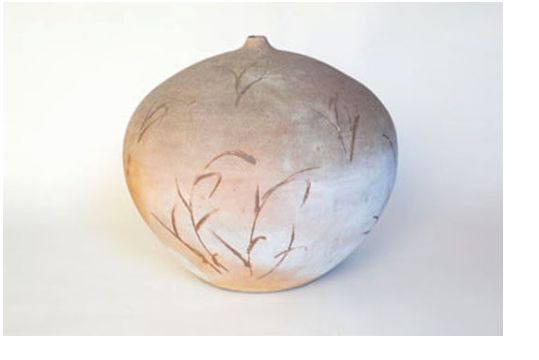
Left: "Cloth Texturing, Autumn Grass Pattern Vase," (w)39.0 -(d)39.0 -(h)34.0 cm, stoneware and slip painting, wood fired and charcoal smoked, traditional way fired to 1250 degrees C., eight-day firing. Exhibited at Traditional Crafts New Exhibition, Nihon Kogeikai, Tokyo, Japan, 1989.Left: "Cloth Texturing, Autumn Grass Pattern Vase," (w)39.0 -(d)39.0 -(h)34.0 cm, stoneware and slip painting, wood fired and charcoal smoked, traditional way fired to 1250 degrees C., eight-day firing. Exhibited at Traditional Crafts New Exhibition, Nihon Kogeikai, Tokyo, Japan, 1989.
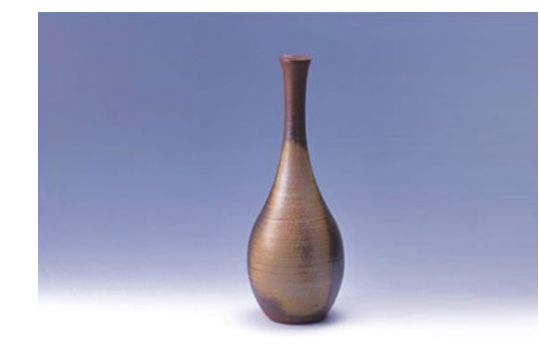
Right: "Bizen-style Long-necked Ovoid Pottery Vase," (w)17.5.0 -(d)17.5 -(h)46.0 cm, wood-fired stoneware with natural wood ash, Bizen traditional way fired to 1250 degrees C., eight-day firing. Exhibited at Leigh Gallery, London, June 15-27, 1993. Collection of The British Museum (U.K.), 1996.
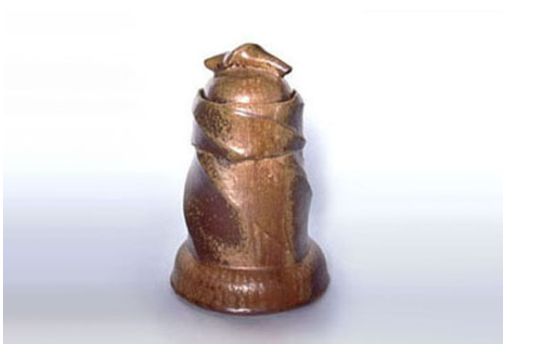
Left: "Faceted Jar with Lid," (w)21.0 - (d)21.0 - (h)33.5cm, wheel-thrown and altered stoneware with natural wood ash, Bizen traditional way fired to 1300 degrees C. oxidation, eight-day firing, "Edge to Edge" Victorian Ceramic Group. Exhibited at Kidogo Arthouse, Bathers Beach Fremantle, Australia, June 27- July 11, 1999.
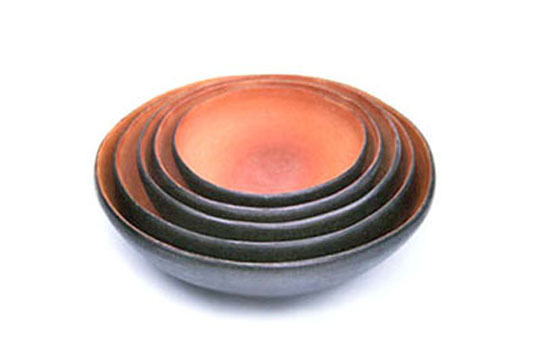
Right: "Bowls in Sets of Five ("Ireko")," smallest (w)17.7 -(d)17.7 -(h)5.5 cm, largest (w)31.3-(d)31.3 -(h)8.5 cm, wheel-thrown and stoneware, salt-water sprayed interior, black slip exterior, bottom upward when stacking kiln, traditional way fired to 1250 degrees C. oxidation, eight-day firing. Published in 500 Bowls: Contemporary Explorations of a Timeless Design, Lark Books, A Division of Sterling Publishing Co., Inc.,New York, U.S.A., 2003.
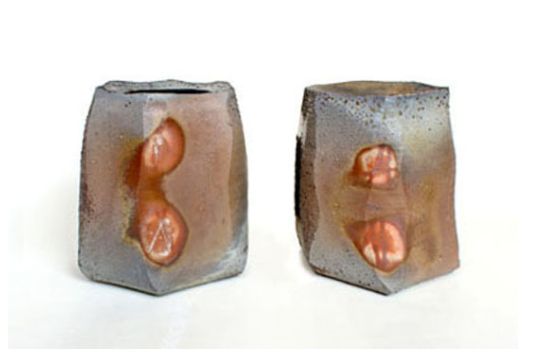
Left: "Vessel: Otherness," (w)58.0 -(d)16.5 -(h)18.5 cm, wheel-thrown and altered stoneware, with natural glaze, fire change, traditional way fired to 1250 degrees C. reduction, eight-day firing, 2nd International Ceramic Triennial UNICUM. Exhibited at European Cultural and Technological Center Maribor (EKTC), Manor Betnava, Slovenia, May 15- September 30, 2012.
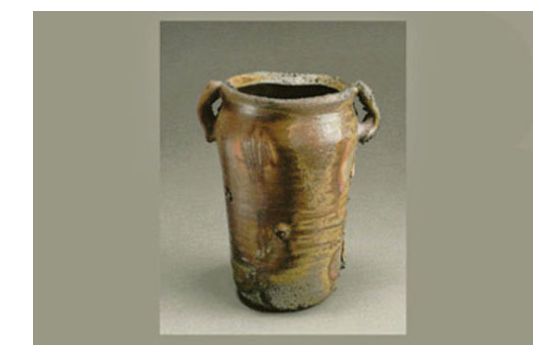
Right: "Side-fired Vase with Lugs," (w)14.0 -(d)10.5 -(h)20.0 cm, wheel-thrown and altered stoneware, with natural wood ash runs, traditional way fired to 1300 degrees C. reduction, eight-day firing. Exhibited at "The First 40 Years" an Exhibition Celebrating the History of the International Ceramics Studio through its Collection of Contemporary Ceramics. The Pesti Vigadó is the seat of the Hungarian Academy of Arts, August 17 -October 8, 2017.
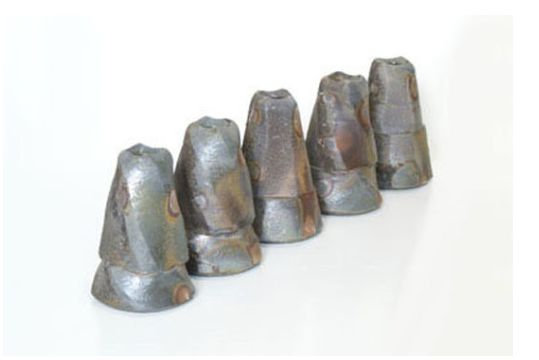
Left: "Vessel; Otherness,” (w)75.0 -(d)12.5 -(h)19.5 cm, wheel-thrown and altered stoneware , with natural glaze, fire change, traditional way fired to 1280 degrees C. reduction, eight-day firing, the 5th Biennial International Competition for Artistic and Traditional Ceramics. Exhibited at the Museo dell'Arte Ceramica in Piazza San Tommaso n ° 11, in Ascoli Piceno, Italy, December 14, 2017- February 5, 2018.
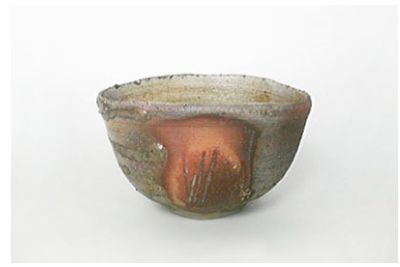
Right: "Bizen-style Side-fired Teabowl," (w)15.5 -(d)12.9 -(h)9.2 cm, wheel-thrown and stoneware, with natural wood ash glaze showing blue glass "fingers" and "dragonfly eye", Bizen traditional way fired to 1280 degrees C. reduction, ten-day firing. Published in 500 Bowls: Contemporary Explorations of a Timeless Design, Lark Books, A Division of Sterling Publishing Co., Inc.,New York, U.S.A., 2003.
The chawan—commonly understood today as a vessel central to the praxis of the Way of Tea—originates in objects of unassuming domestic utility, its genealogy extending back to the rudimentary woodenware known as goki. As ceramic technologies evolved and the ontological status of fired clay expanded, quotidian bowls such as the rice bowl gradually accrued cultural valence, shaped by the longue durée of daily use and the incremental refinement of artisanal technique.
Within the highly codified yet contemplative framework of chanoyu, these modest implements underwent a profound epistemic reconfiguration. Through the interpretive agency of tea masters, the chawan was not merely appreciated but re-inscribed within an aesthetic discourse that foregrounded seeing as the capacity to apprehend latent beauty within forms initially constituted for use rather than display. The authority of such bowls thus emerged less from authorship than from a phenomenological shift—a recognition that beauty may be disclosed, contingent upon context, ritual, and the cultivated gaze.
This reorientation of perception parallels the discursive rupture introduced into modern art by Marcel Duchamp, whose presentation of an ordinary sanitary fixture—the utilitarian urinal later canonized as Fountain—intervened decisively in the conditions by which objects could be designated as art. By repositioning ready-made artifacts such as the bicycle wheel and the humble stool, Duchamp destabilized entrenched assumptions of authorship, medium specificity, and aesthetic intentionality, expanding the epistemic field of what might legitimately enter the category of the “artwork.”
Analogously, the chawan occupies a liminal zone between functionality and transcendence. It is an object constituted not solely by material form but by a confluence of hand, historical sedimentation, and the interpretive frameworks through which it is apprehended. In this sense, the chawan exemplifies how a utilitarian form may attain aesthetic significance through shifts in cultural ontology and the transformative potential of perception itself.

